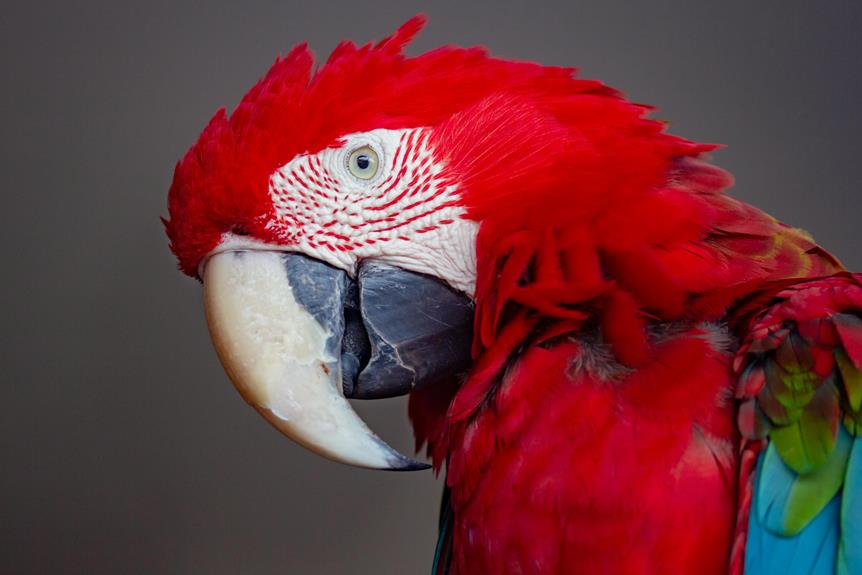
To socialize and bond with your pet bird, start by understanding its body language cues like chirping happily for contentment or pacing for stress. Engage in interactive playtime with toys that encourage natural behaviors and set up a play area for exploration. Provide enrichment with new toys and challenges, hide treats for foraging, and establish a daily routine for feeding, interaction, and rest. By focusing on these key aspects, you can strengthen your bond with your feathered friend and enhance your relationship further.
Understanding Your Birds Body Language
When bonding with your pet bird, understanding its body language is crucial for building a strong and trusting relationship. Birds communicate a lot through their body movements and gestures. For example, if your bird is fluffing up its feathers and chirping happily, it means they're content and feeling secure in your presence. On the other hand, if your bird is pacing back and forth on its perch or biting at its cage bars, it could be a sign of stress or boredom.
Pay attention to your bird's eyes as well. Wide eyes could indicate excitement or fear, while half-closed eyes might mean your bird is feeling sleepy or relaxed. Understanding these subtle cues will help you respond appropriately to your bird's needs and emotions.
Additionally, observe your bird's posture. A bird that's standing tall with its feathers sleeked back is likely feeling confident and alert. Conversely, a bird that's hunched over with ruffled feathers may be unwell or scared. By being attentive to these signals, you can strengthen the bond with your feathered friend and ensure a harmonious relationship.
Engaging in Interactive Playtime
To strengthen your bond with your pet bird, actively engage in interactive playtime to provide mental stimulation and physical exercise. Interactive playtime is crucial for keeping your bird's mind sharp and promoting physical health. Choose toys that encourage natural behaviors like foraging, climbing, or shredding. Rotate toys regularly to keep your bird engaged and prevent boredom.
During playtime, interact with your bird by using toys that require your participation, such as puzzle feeders or toys you can manipulate together. This not only stimulates your bird's problem-solving skills but also fosters a sense of companionship between you and your feathered friend. Incorporate training sessions into playtime using positive reinforcement techniques to reinforce good behaviors and strengthen your bond.
Additionally, consider setting up a play gym or designated play area where your bird can explore, exercise, and play freely outside of its cage. Supervised out-of-cage playtime provides mental and physical enrichment while allowing your bird to stretch its wings and interact with you in a different environment. By actively participating in interactive playtime, you'll create lasting memories and deepen your bond with your pet bird.
Providing Enrichment Activities
Engage your pet bird in stimulating enrichment activities to keep them mentally and physically engaged. Introducing new toys, puzzles, and challenges can help prevent boredom and encourage natural behaviors. Consider providing foraging opportunities by hiding treats in toys or creating a foraging box filled with shreddable material. Rotate their toys regularly to maintain their interest and prevent habituation.
Another great way to enrich your bird's environment is by setting up a bird-safe play area outside of their cage. This space can include perches, ladders, and interactive toys to promote physical activity and exploration. You can also create a bird-friendly obstacle course using safe materials like wooden blocks or cardboard tubes.
Incorporating training sessions into your bird's routine isn't only mentally stimulating but also strengthens your bond. Teach them simple tricks or behaviors using positive reinforcement and treats. Training sessions provide mental challenges and allow for quality one-on-one time with your feathered friend.
Establishing a Daily Routine
Wondering how you can create a structured daily routine for your pet bird that promotes their well-being and happiness? Establishing a consistent daily schedule is crucial for your feathered friend's overall health and contentment. Start by setting regular times for feeding, social interaction, playtime, and rest. Birds thrive on routine, so try to maintain consistency in these activities each day.
Begin the day by uncovering your bird's cage and greeting them with a cheerful hello. Providing fresh food and water should follow shortly after. Interact with your pet bird during meal times, as this is a great opportunity to bond. Throughout the day, allocate specific periods for activities like training sessions, out-of-cage exploration, and mental stimulation with toys.
In the evening, gradually dim the lights to signal bedtime. Covering the cage can help create a cozy and secure sleeping environment. By establishing a daily routine tailored to your pet bird's needs, you can enhance their well-being and strengthen your bond.
Conclusion
In conclusion, by paying attention to your bird's body language, engaging in interactive playtime, providing enrichment activities, and establishing a daily routine, you can create a strong bond and socialize effectively with your pet bird.
Remember to be patient, consistent, and understanding of your bird's needs to ensure a happy and fulfilling relationship.
Enjoy the special moments you share with your feathered friend!




